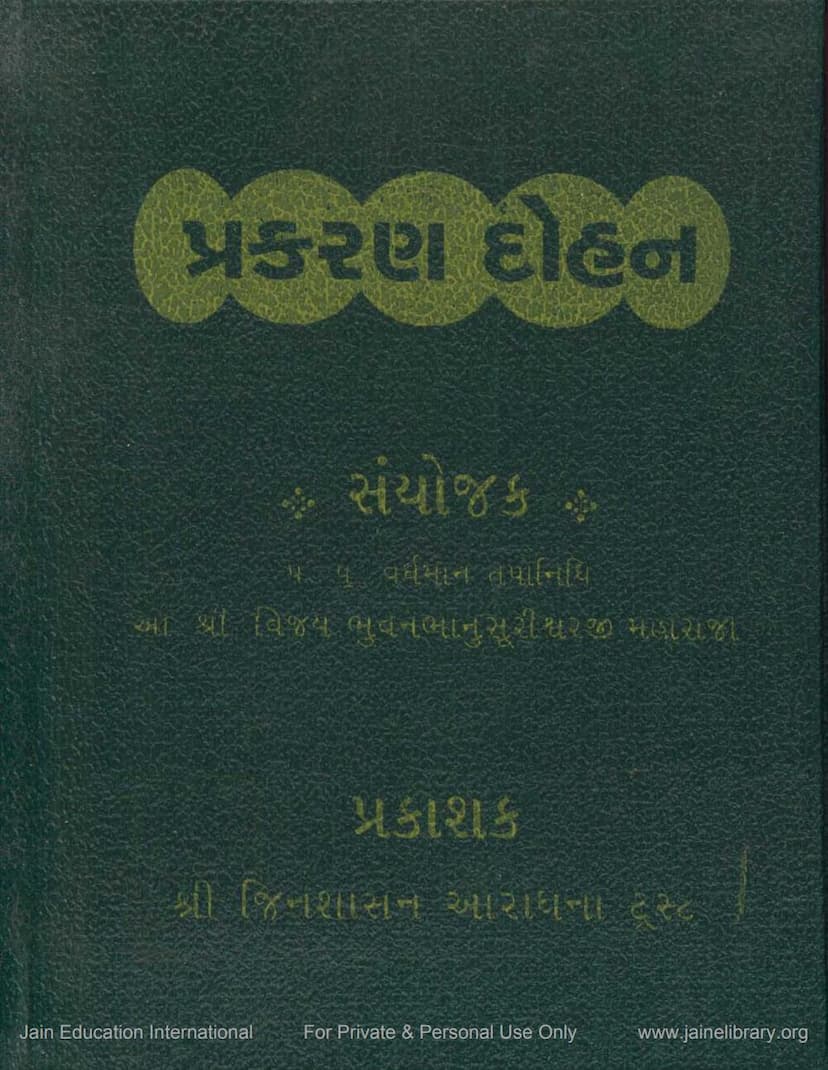Prakarana Dohan
Added to library: September 2, 2025

Summary
Here's a comprehensive summary of the Jain text "Prakarana Dohan" by Bhuvanbhanusuri, based on the provided pages:
Title: Prakarana Dohan (પ્રકરણ દોહન) Author: Acharya Vijay Bhuvanbhanusuri (A.ashri Vijay Bhuvanbhanusuri) Compiler: Muni KalyanaBodhi Vijay (Munishri KalyanaBodhi Vijay) Publisher: Shri Jinshasan Aradhana Trust (Shri Jinshasan Aradhana Trust) Content: The book is a compilation and brief commentary on key philosophical concepts of Jainism. It aims to condense and present the essence of several important Jain texts and principles.
Core Subject Areas Covered:
The book is structured to provide a concise understanding of the following foundational Jain topics:
-
Jiva Vichar (જીવવિચાર): This section deals with the concept of the soul (Jiva). It explains the characteristics of the soul, its different states (mundane and liberated), and the various classifications of souls based on their number of senses, mobility (Sthavar and Trasa), and other attributes. It details the five types of immobile souls (earth-bodied, water-bodied, fire-bodied, air-bodied, and plant-bodied souls) and their respective sub-classifications. It also explains the classifications of mobile souls (two-sensed, three-sensed, four-sensed, and five-sensed) and the categories within five-sensed beings (hellish beings, animals, humans, and celestial beings). The text provides a detailed breakdown of the 563 types of souls.
-
Nava Tattva (નવતત્ત્વ): This fundamental Jain doctrine explains the nine essential truths or categories for understanding the path to liberation. The book briefly defines and explains each of the nine tattvas:
- Jiva (Living Soul): The conscious substance.
- Ajiva (Non-living Substance): The unconscious substance.
- Karma: The subtle matter that adheres to the soul and causes bondage.
- Asrava (Influx): The channels through which karmas enter the soul.
- Samvara (Stoppage): The process of blocking the influx of karma.
- Nirjara (Shedding of Karma): The process of causing karma to fall away from the soul.
- Bandha (Bondage): The state of the soul being bound by karma.
- Nirvana/Moksha (Liberation): The ultimate state of freedom from karma and suffering. The text elaborates on the distinctions within these tattvas, including the types of souls, the characteristics of liberated souls, and the specific nature of karma. It outlines the 14 types of souls, 14 non-living substances, 42 types of merit (punya), 82 types of demerit (papa), 42 influxes, 57 types of stoppage, 12 types of karma shedding, and 4 types of bondage.
-
Dandaka (દંડક): This section discusses the "Dandakas," which are classifications or categories of beings and their states within the Jain cosmology. The text explains the concept of Dandakas as significant points or states within the religious and philosophical framework. It mentions 24 Dandakas, each with corresponding explanatory "Dwaras" (gates or sub-points). These Dandakas are related to different aspects of existence, including the body, senses, lifespan, consciousness, and the destinations of beings.
-
Laghu Sangrahani (લઘુ સંગ્રહણી): This part is a condensed summary of the Jain universe and its geography, particularly focusing on Jambudvipa, the central continent in Jain cosmology. It describes the structure of the universe, including the Lokakasha (space where beings exist) and Alokakasha (non-existent space). It details the Jambudvipa continent, its dimensions, the various lands (Kshetras), mountains (Varshadharas), rivers, lakes, and the divine palaces of the Adhipati Devtas. The text mentions the 34 Vivara-Kshetras, the celestial beings residing in them, and the paths of celestial beings.
-
Karma Granth (कर्मग्रंथ - Part 1): The book includes the initial part of a commentary on Karma Granth, a significant Jain text detailing the intricacies of karmic matter and its influence on the soul. This section touches upon the eight types of karmas and their sub-classifications, explaining how they obscure the soul's inherent qualities like knowledge, perception, bliss, and energy. It details the Ghati (destructive) karmas (Jnanavaraniya, Darshanavaraniya, Mohaniya, Antaraya) and the Aghati (non-destructive) karmas (Vedaniya, Ayushya, Nama, Gotra).
-
Chaitya Vandan, Guru Vandan, Pacchakhan Bhashya (ચૈત્યવંદન, ગુરુવંદન, પચ્ચક્ખાણ ભાષ્ય):
- Chaitya Vandan Bhashya: This section provides a detailed exposition on the ritual of worshipping Jain temples and idols (Chaitya Vandan). It outlines the proper procedures, the correct posture, the devotional gestures, and the specific mantras or verses to be recited. It explains the different types of worship (Pooja) and the significance of various elements involved.
- Guru Vandan Bhashya: This part focuses on the importance and correct methods of venerating the Guru (spiritual preceptor). It emphasizes the principles of respect, humility, and proper conduct towards spiritual guides, detailing various forms of salutation and service. It highlights the role of Vinaya (respectful conduct) as fundamental to spiritual progress.
- Pacchakhan Bhashya: This section explains the Jain vows and resolutions (Pacchakhan/Pratyakhyan), which involve abstaining from certain actions or substances. It describes the different types of vows, the rules for taking them, the exceptions (Agara), and the conditions under which they can be modified or broken. It emphasizes the spiritual benefits of observing these vows.
Key Themes and Emphasis:
- Conciseness and Clarity: The book aims to simplify complex Jain philosophical concepts, making them accessible to a wider audience.
- Systematic Compilation: It systematically gathers and presents information from various authoritative Jain scriptures.
- Practical Application: While covering theoretical aspects, it also provides guidance on the practical observance of rituals and vows, such as Chaitya Vandan and Pacchakhan.
- Spiritual Progression: The underlying message is to guide the reader towards spiritual progress through the understanding and practice of Jain principles, ultimately leading to liberation (Moksha).
- Author's Expertise: The text highlights the profound knowledge and profound insight of Acharya Vijay Bhuvanbhanusuri in condensing vast scriptural knowledge into a comprehensible format.
In essence, "Prakarana Dohan" serves as an introductory guide to the core doctrines and practices of Jainism, compiled with the intention of facilitating the spiritual journey of its readers. It is a valuable resource for those seeking to understand the fundamental principles of the Jain faith.